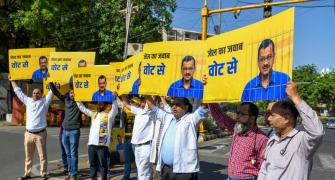It is always good to know of some real progress in the power sector where only daily power cuts and capacity addition delays make the headlines. There finally seem to be some serious signs of an attack on the biggest problem facing this sector -- transmission and distribution losses -- which eat up over a third of the power generated in the country.
This seminal move promises to fundamentally change the power landscape over the next few years.
The attack, worth over Rs 50,000 crore ($10 billion), has been in the works for quite some time but actually began in July last year, when the Revised Accelerated Power Development and Reform Programme was approved by the Cabinet.
Given the problems that were faced by the original APDRP programme, the focus this time around is on 'actual demonstrable performance in terms of sustained loss reduction'.
The programme involves the establishment of baseline loss data verified by an independent third party in the first phase, for which Rs 10,000 crore (Rs 100 billion) has been budgeted. The rest of the funds would be used for actual upgradation of the transmission and distribution system in the second phase, for all towns with a population of 30,000 or more.
Only on actual progress in reduction of losses will the funding advanced to government-owned utilities in the form of a loan be converted to a grant fully (in the case of the first phase) or partially (in the second phase).
Many utilities have already been enticed by the lure of this money and have taken the critical first steps towards the reduction of aggregate technical and commercial losses (which is a
broader measure of transmission and distribution losses) to the targeted 15 per cent.
The programme is already gaining traction. Almost Rs 2,000 crore (Rs 20 billion) has already been sanctioned to 25 utilities across 13 states. Andhra has mopped up almost a fifth of these sanctions. Other states which have managed significant sanctions include Maharashtra, Rajasthan and Haryana. And all this was done in the January-March quarter.
Power Finance Corporation, the nodal agency for implementing this programme, has targeted sanctions, and disbursements, of another Rs 1,900 crore (Rs 19 billion) this financial year.
One drawback of the scheme, however, is that it does not extend to private distribution utilities. So a pioneering state like Orissa, which began its reforms way back in the early 1990s and has privatised distribution utilities, cannot avail of this scheme even though it is grappling with very high losses on transmission and distribution.
This proviso would also prevent other states from going ahead with privatisation of distribution utilities if they are considering it at all. Curtailment of losses means an augmentation to power supply, which would be most welcome in the backdrop of scanty additions to generation capacity in the recent past.
This addition to supply through efficiency improvements and loss reduction -- loosely referred to as negawatt - will lead to a welcome dip in energy deficits running in double digits.
It has often been said that adding capacity without attacking the problem of transmission and distribution losses is like adding water to a leaky bucket. Now that work on stemming the leak has begun, it is also time to look at adding new supply to the power pool.
Good old megawatts need to flow in with the negawatts, and that is where minister Sushil Kumar Shinde, who took charge on Sunday, needs to focus his efforts.
Between 2006 and 2009, four of the country's largest power generation projects have been awarded to private sector developers at Sasan, Mundra, Krishnapatnam and Tilaiya through a tariff-based competitive bidding process. These projects of 4,000 Mw each are examples of a successful PPP initiative of the government in the form of ultra mega power projects.
Unfortunately, it seems like the current financial year would be a blank as far as these projects are concerned though there are three states that are ready to host the next set of ultra mega projects -- Tamil Nadu, Chattisgarh and Orissa - and there are others like Andhra and Gujarat which are keen on a second ultra mega project. Shinde should provide the required push to the ultra mega power projects programme so that at least one project is awarded this year. He could also consider selling the next two projects simultaneously -- as was done in the case of Sasan and Mundra.
Further, the minister should insist on some element of realism in capacity addition targets rather than blithely talk about 100,000 Mw of new capacity coming online in the 11th Plan, as he did on Sunday!








